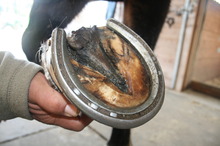
Over the years we humans have selected horses for things other than sound feet. Dropped soles or flat feet are often determined by an animal’s DNA. This is especially true in the racing and sport horse breeds. We have selected these horses for speed and jumping ability and then protected them from natural selection due to foot unsoundness by expert foot care.
By breeding horses with these conformations we perpetuate these undesirable conditions. Their soles are often flat and thin. The feet of these over-selected horses must be frequently balanced and shod with seated-out (beveled away from the sole), wide-webbed shoes to protect the sole from bruising and bearing weight. Many must be padded to stay sound enough to endure athletic activity. The use of frog support or heart-bar shoes to distribute weight over a greater area of the foot may be necessary to maintain soundness.
Horses with dropped soles may stay sound for a long time with proper hoof maintenance.
Horses kept in very wet environments may develop spreading or flaring hooves. Over time the distal phalanx bone or coffin bone in neglected feet remodels and the sole becomes flat. Excessive bone remodeling due to inflammation of the distal phalanx may result in pedal osteitis. When this happens to horses in the wild, lame horses may become subject to predators. Domesticated horses depend upon us to keep their hooves maintained and protected by frequent trimming, and if necessary, shoeing. Making provision for horses to get on dry ground for at least part of a day helps too. Too much moisture can be worse for foot health than too little.
Founder is a serious systemic disease that affects the horse’s feet. Horses that have foundered will have dropped soles. Laminitis turns into founder when the distal phalanx bone rotates or sinks within the hoof capsule due to the death of the interlocking laminar leaves which suspend the bone from the hoof wall. This attachment is normally like new Velcro and very strong. Once destroyed, the bone sinks and bruises the sole from above causing it to flatten or drop. Due to the pressure placed upon the circumflex artery – compromising the blood supply to the sole, and the circumflex nerve – causing intense pain, the horse may develop abscesses and become very lame.
Eventually, if the horse survives the initial disease insult, the sole remains in a “dropped” or flattened position. Heart bar shoes that act like arch supports are frequently used to mechanically treat founder and in my experience give the greatest chance for a successful recovery. There is less circulation under the frog than the sole and it can bear a portion of the horse’s weight to relieve the pressure on the sole. These shoes must be fit with precision to be effective. Packing the rear portion of the foot with composite material to relieve the pain at the toe may also be effective. A few horses may need therapeutic shoes all of their lives.
Horses with dropped soles may stay sound for a long time with proper hoof maintenance. Care must be exercised to prevent bruising of the coffin bone and distribute pressure away from painful areas. This may be accomplished by trimming in some cases, but others require seated-out frog support shoes. Your professional farrier can advise you on the best course of action for your horse.

